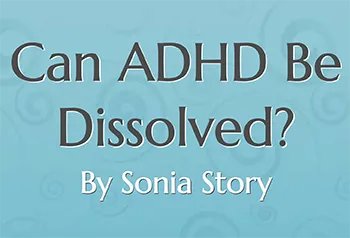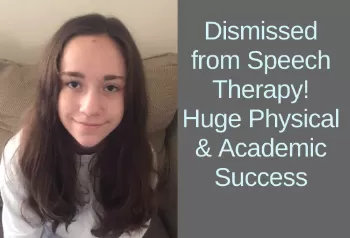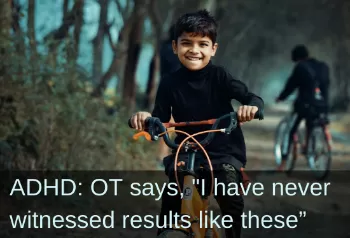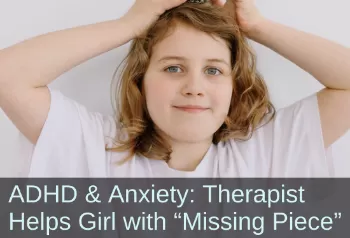Overcoming ADHD Symptoms with Reflex Integration
 by Sonia Story, M.S.
by Sonia Story, M.S.
Huge numbers of children and adults suffer from Attention Deficit Hyperactivity Disorder (ADHD). ADHD symptoms—characterized by age-inappropriate lack of focus, hyperactivity, and impulsivity—often come with learning, anxiety, and social challenges.
ADHD symptoms also go hand-in-hand with unintegrated primitive reflexes (Wang et al., 2023; Konicarova et al., 2014; Taylor, 2004) and with sensory processing challenges (Konicarova et al., 2014; Ghanizadeh, 2011; Zang et al, 2002).
Research also shows that the brains of children and adults with ADHD are less mature than the brains of individuals who do not have ADHD symptoms (Hoogman et al., 2017; Sripada et al., 2014; Rubia, 2007).
This leads to important questions: Can improvement in sensory-motor skills lead to more brain maturity? And can movements that foster brain maturity lead to the dissolving of ADHD symptoms?
Harald Blomberg, MD answers “Yes” to these questions. Based on decades of experience, Blomberg, a psychiatrist, recommends targeted innate infant movements (rhythmic movements, and primitive reflex integration movements) to increase brain maturity and help children and adults overcome ADHD symptoms (Blomberg & Dempsey, 2011). Blomberg gives an example of a young boy with severe ADHD and behavior problems:
“[Using innate rhythmic and reflex integration movements] you can expect great improvement and even total recovery from ADHD, which was proven by [one] of my patients who had been on medication for six years since he was six [years old], when he was diagnosed with ADHD. In spite of the medication his symptoms only got worse and he had severe symptoms when he first started...He had severe temper tantrums, severe attention problems, impulsivity, etc., and attended school in a special class with seven students and five adults. After 8 months [of doing innate movements] he joined a normal class and after 18 months [of doing innate movements] he functioned perfectly. Recently he went back to the child psychiatric clinic to get his diagnosis cancelled. He made all the diagnostic tests and it was established he no longer had ADHD” (Blomberg, 2008).
According to Blomberg, ADHD symptoms are caused by underdevelopment of the brain, body, and sensory systems. This underdevelopment happens in large part at the beginning of life, when a child does not get full exposure to all of the innate movements during womb-life, birth, infant, and toddler stages.
There is a body of research that supports the view of ADHD as delayed maturation or underdevelopment of the brain (Rubia, 2007 and Shaw et al., 2007).
Though more research is needed, it appears that when we provide these innate movements to individuals, the brain resumes development where it left off. Best of all, when children receive enough of the many types of innate movements, we see very positive changes as more brain maturity is gradually built. Children are able to release anxiety, be still, sleep better, focus, learn, and finish school work. Along with the brain, the body also matures and children develop much better posture, strength, stamina, and comfort.
It sounds miraculous that these innate movements can change the brain and body! Yet this is the same miraculous process that happens naturally in human development. When there is a hindrance in our natural development, it allows problems like ADHD symptoms to take root.
Profound Transformation
Here is another example of the transformative power of innate rhythmic and reflex integration movements. At 10 years old, Andy had been diagnosed with moderately severe ADHD. Andy tested below grade level in all subjects at school. He was socially awkward and physically clumsy.
After 4.5 months of doing innate rhythmic and primitive reflexes movements, Andy’s mom reported:
“I am amazed at the things he has accomplished as a result of the reflex integration exercises, including catching objects being thrown to him. His balance has improved and he enjoys riding his bicycle without encouragement to do so. Most importantly, for the first time since he began school, he now tests at grade level in every area except one. And the one was only two points off. This is after testing as low as two grade levels behind in previous years. Andy has begun to join in activities at Boy Scouts and with friends at school. We are beginning to see some maturing and consciousness of himself around other people, making him more socially acceptable to others and not that ‘different kid’."
Fueling Development Through Movement
According to Blomberg, there is a simple explanation for the profound transformation that Andy and many others have experienced using these innate movements. Blomberg explains that ADHD behaviors—lack of focus, distractibility, and poor impulse control—are also seen in normal development around the ages of one to three years. Children who later end up with a diagnosis of ADHD remain in a less mature state because they have not fully built the brain and body connections needed to reach a more mature state. While school children with ADHD do not literally behave like toddlers, they can struggle with sensory-motor issues, poor attention, and behavior challenges because of underdevelopment. Depending on the severity of underdevelopment, this can make everyday tasks and school work very challenging and tiring.
The good news is the underdevelopment seen in ADHD can change by tapping into the innate movements that fuel our development in infancy, allowing the brain and body to literally grow out of ADHD symptoms. For many individuals, this can be accomplished in 15-25 minutes a day of targeted rhythmic and reflex integration movements. See case study examples of transformation using the tools from the Brain and Sensory Foundations course.
Blomberg also acknowledges that nutrition and overall health play important roles in helping with ADHD symptoms. Along with good health and nutrition, providing innate movements is critically important for dissolving ADHD symptoms. There is great hope for children who suffer from ADHD. With brain-enhancing innate movements, these children can live happier, more effective lives and find success doing what is meaningful for them.
Focus and calm improve Homework, Learning, and Daily Tasks for Teen
This teenager was struggling with emotional regulation and focus. Read about his tremendous positive results using movements from the Brain and Sensory Foundations, First Level course.
From IEP to all As and Bs on Report Card! This 12-year-old girl had ongoing struggles with her attention, expressive and receptive language, math skills, and social confidence. Using tools from the Brain and Sensory Foundations First Level course, her mom was able to help her improve her math scores, writing skills, and speech—to such an extent, she no longer needs speech therapy.
ADHD: In 2 months OT sees “profound improvements across multiple functional areas” The use of innate rhythmic movements and primitive reflex integration from the Brain and Sensory Foundations First Level course results in huge improvement for anxiety, motor skills, focus, and much more! Find out why this OT was so impressed.
10-Yr-Old Girl with Anxiety and ADHD: Gains Calm, Confidence, and Focus This 10-year-old girl was referred to occupational therapy to address self-regulation, coping skills, coordination and motor planning, and executive functioning. See how she experienced huge improvements in self-regulation, sleep, confidence, and calm.
See more inspiring case studies involving ADHD/ADD.
References
Blomberg, H. & Dempsey, M. (2011). Movements That Heal: Rhythmic Movement Training and Primitive Reflex Integration. Sunnybank Hills, Qld.: Book Pal.
Blomberg, H. (2008, June 20) Personal email communication.
Ghanizadeh, A. (2011). Sensory processing problems in children with ADHD, a systematic review. Psychiatry Investig, 8(2), 89–94.
Hoogman, M., Bralten, J., Hibar, D.P., Mennes, M., Zwiers, M.P., Schweren, L.S.J., van Hulzen, K.J.E., Medland, S.E., et al. (2017) Subcortical brain volume differences in participants with attention deficit hyperactivity disorder in children and adults: a cross-sectional mega-analysis. Lancet Psychiatry. 4(4), 310-319.
Konicarova, J., Bob, P., & Raboch, J. (2014). Balance deficits and ADHD symptoms in medication-naïve school-aged boys. Neuropsychiatric Disease and Treatment, 85.
Rubia, K., (2007) Neuro-anatomic evidence for the maturational delay hypothesis of ADHD. Proceedings of the National Academy of Sciences, 104(50), 19663-19664.
Shaw, P., Eckstrand, K., Sharp, W., Blumenthal, J., Lerch, J.P., Greenstein, D., Clasen, L., & Evans, A. (2007) Attention-deficit/hyperactivity disorder is characterized by a delay in cortical maturation. Proceedings of the National Academy of Sciences. 104(49):19649-54.
Sripada, C.S., Kessler, D., & Angstadt, M. (2014). Lag in maturation of the brain’s intrinsic functional architecture in attention-deficit/hyperactivity disorder. Proceedings of the National Academy of Sciences. 111(39), 14259-14264.
Taylor, M., Chapman, E., & Houghton, S. (2004). Primitive reflexes and attention-deficit/hyperactivity disorder: Developmental origins of classroom dysfunction. International Journal of Special Education, 19(1), 23-37.
Wang, M., Yu, J., Kim, H. D., & Cruz, A. B. (2023). Attention deficit hyperactivity disorder is associated with (a) symmetric tonic neck primitive reflexes: a systematic review and meta-analysis. Frontiers in Psychiatry, 14, 1175974.
Zang, Y., Gu, B., Qian, Q., & Wang, Y. (2002) Objective measurement of the balance dysfunction in attention deficit hyperactivity disorder children. Chinese Journal of Clinical Rehabilitation. 6(9).
Sonia Story, M.S. has been teaching neurodevelopmental movements since 2006.
Sonia developed the Brain and Sensory Foundations program to provide comprehensive training in neurodevelopmental movements—combining innate rhythmic movements, play, primitive reflexes, and postural reflexes.
She earned a Bachelor's degree in biology/psychology and a Master’s degree in Movement Sciences. She is the author of The Importance of Reflex Integration and the Evidence eBook, giving the rationale and evidence basis for using neurodevelopmental movements for helping with challenges such as ADHD, Sensory Processing Disorders, anxiety, emotional dysregulation, visual skill deficits, poor social skills, gross and fine motor delays and other neurodevelopmental and behavioral disorders.
Her work is featured in numerous podcasts, summits, and conferences, and in the books Almost Autism: Recovering Children from Sensory Processing Disorder; Special Ed Mom Survival Guide; Family Health Revolution; and Same Journey, Different Paths—Stories of Auditory Processing Disorder.
Sonia’s mission is to help children and families experience the profound benefits of neurodevelopmental and integrative movements for more functional and fulfilling lives.






